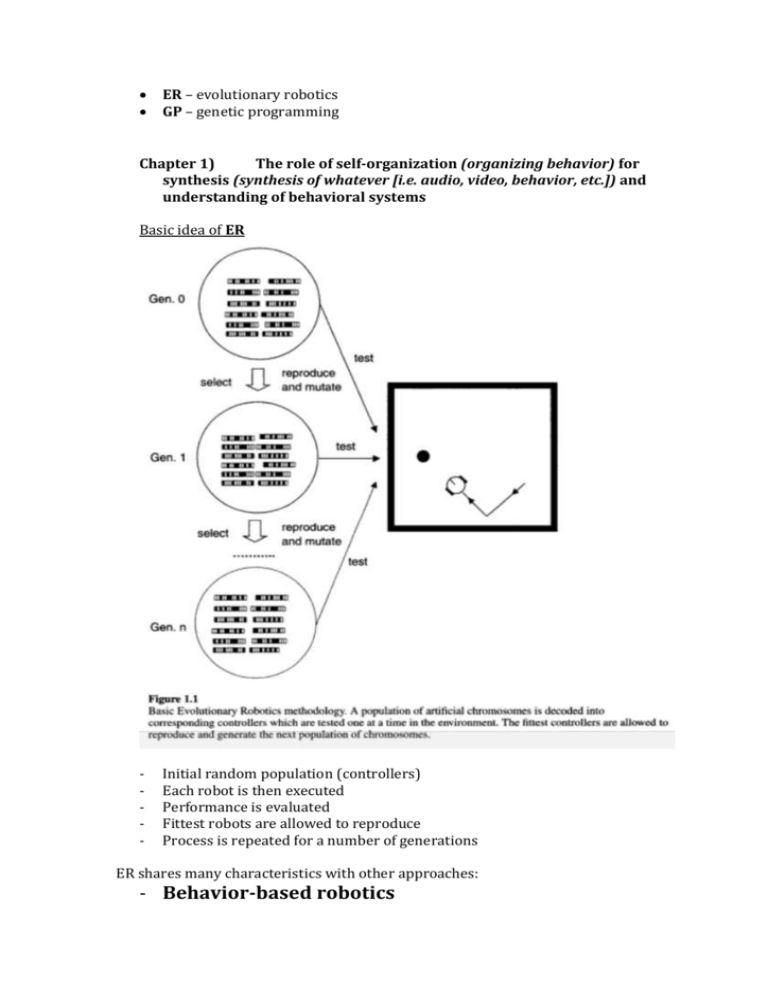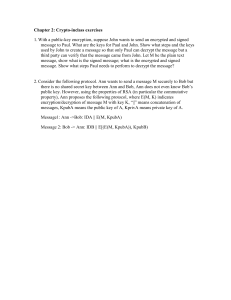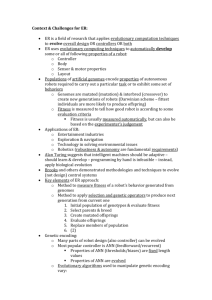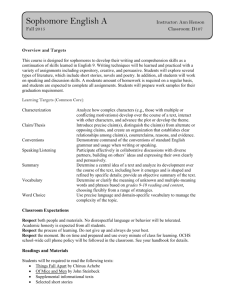the biology, technology, intelligence of self
advertisement

ER – evolutionary robotics
GP – genetic programming
Chapter 1)
The role of self-organization (organizing behavior) for
synthesis (synthesis of whatever [i.e. audio, video, behavior, etc.]) and
understanding of behavioral systems
Basic idea of ER
-
Initial random population (controllers)
Each robot is then executed
Performance is evaluated
Fittest robots are allowed to reproduce
Process is repeated for a number of generations
ER shares many characteristics with other approaches:
- Behavior-based robotics
Give a robot collection of simple basic behaviors. Complex behavior
of a robot emerges from interaction of simple behaviors and the
environment. (Brooks)
Simple behaviors are encoded separately. Separate mechanism
decides to what degree each simple behavior contibutes to the total
complex behavior. Simple behaviors can interoperate in either:
Competitive – only 1 simple behavior affects an output (i.e. Brook’s
subsumption method) or
Cooperative – different simple behaviors contribute to an output
(with different strengths [i.e. Arkin’s behavioral fusion via vector
summation]).
method.
Same as in ER, environment plays central role in determining the
role of each simple behavior
Usually designed through trial-and-error (programmer modifies
simple behaviors & increases # of simple behaviors) while observing
complex behaviors
Breakdown of the desired behavior into simpler behaviors is done
intuitively by the designer (in ER this is a result of self-organizing
process)
- Robot learning
Idea: control system (ANN) can be trained using incomplete data
and then generalize the acquired knowledge to new situations (what I
am trying to do now with controller in webots)
Learning algorithms: (impose constraints on type of
architecture that can be used and on quality & quantity of supervision
required from designer [i.e. if back-propagation is used, the designer
must provide correct values for the outputs for the wheels of the robot
during learning])
- back-propagation learning
- reinforcement learning
- classifier systems
- self-organized maps
- etc
Reinforcement learning is only used to evaluate whether robot is
doing good or bad (different from back-propagation)
Artificial evolution may be seen as a way of learning
2 differences (ER vs Robot learning):
1. Amount of supervision in evolution is much
lower (only general evaluation – “how well robot
performs task he is asked to perform”)
2. Evolution does not put any constraints on what
can be part of self-organization process (i.e.
characteristics of sensors, shape of robot, etc. ->
these can be included in evolutionary process)
^^ result of evolutionary experiment
- Artificial life
Artificial life attempts to understand life phenomena through
simulation.
In complex dynamical system’s properties emerge from simple
elements at lower levels (complex dynamic properties cannot be
predicted [eventhough emerging from simpler properties])
ER shares these characteristics with artificial life
When using real robots, several factors must be taken into account: (Brooks)
- Friction
- Inertia
- Light
- Noise
- etc
Only information available in the environment can be used for training
Behavior is an emergent property of the interaction between the robot and the
environment. As a consequence, simple robots can produce complex behavior.
(Braitenberg)
Properties of emergent behavior cannot easily be predicted from knowledge of
rules that govern interactions (Inversely, it is difficult to predict which rules will
produce which behavior)
Divide-and-conquer approach was used in traditional robotics (breakdown into
Perception, Planning, and Action) -> has been criticised by many and produced
limited results. Brooks proposed different approach, in which the division is
accomplished at the level of behavior (desired behavior is broken down into set
of simpler behaviors).
Control system is built incrementally (layer-by-layer), where each layer is
responsible for simple behavior by directly linking sensors to motors. (more
successful than the traditional approach^^)
It was said that the structure of behavioral modules should emerge, not be preprogrammed
Why it is difficult to break complex behavior into simple behaviors?
We should analyse complex behavior from 2 perspecives:
1) From human perspective
2) From robot perspective
Breakdown is accomplished intuitively by researcher.
The fact that complex behavior can be divided into a set of simpler behaviors
DOES NOT imply that simple behaviors can be implemented into separate layers
of agents control system.
ER frees developer from deciding about how to break desired complex
behavior into simple behaviors (by relying on evaluation)
Example: If we divide complex behavior, like “following the line, not colliding
with objects, coming back to line, etc.” into simple bahaviors and try to
train 4 separate ANNs to perform each basic behavior, the controller will
not function properly. On the contrary, we can easily evolve a single
network to produce 4 different simple behaviors if we select individuals
for their ability to perform complex behavior. (Proposes a [fully
connected] perceptron with many inputs [all sensors] and 2 outputs
[speed of 2 wheels] can produce complex behavior)
Better results are obtained if each module? is result of self-organization process
(not decision made by designer)
Complex behavior cannot be explained by internal mechanisms of an agent
only.
Example: distinguish how big an object is by using only: (possible – agent can
circle around objects)
1) move forward;
2) avoid objects;
3) turn toward object;
Interaction with environment is unexplored (i.e. sensory-motor coordination)
For an agent that interacts with external environment, each motor action has 2
effects:
1) It partially determines how well the agent performs with respect to a
given task
2) It partially determines the next sensory pattern the agent will receive
from the environment (which may determine whether agent will be
able to solve its task or not)
It is very difficult to determine which motor action the agent should perform
each time, taking into account both 1) and 2) [+ each motor action can have
long-term consequences]
ER (relying on self-organization) is not affected by neither 1) nor 2) ->
therefore is an ideal framework for studying adaptive behavior.
Many evolved robots exploit active interaction with environment in order to
maximize behavior selection criteria.
In biology, it is possible to develop complex behavior without increasing the
amount of supervision by:
1) By competitions between or within species
If we wish to select individuals able to solve a task that requires
specific competence, the easiest thing to do is to select individuals for
their ability to solve that specific task. -> design fitness function that
scores individuals acording to their ability to solve that task (can only
work for simple tasks -> for complex tasks, everyone will score 0
[NULL] -> BOOTSTRAP problem)
Possible solutions:
a) Increase amount of supervision
b) Start evolutionary process with simplified version of the task
and then increase the complexity by modifying the fitness.
Example: victims try to run away from predator
2) By letting the system to extract supervision from the
environment
Environment does not tell agent how it should act to attain given
goal
Example: Using sensors, a robot can learn the consequence of its
actions in different environments.
2 ways of adapting to environment:
In principle, any ability that can be acquired
1) through lifetime learning (how agent can interpret
information whether it is doing good or bad? Or what
the agent should do?)
can also be genetically acquired
2) through evolution
Example: An individual that is born to be able to produce a
behavior that is effective in different environments is equivalent
to another individual that can adapt to each environment through
lifetime learning (both individuals are oganized in different
ways). [Individuals who adapt to each environment, should be
able to detect the environment in which they are located and
should be able to modify their strategy accordingly. Individuals
that are born with such adoption capabilities, do not need to
change – more effective -> do not have to undergo adaptation
process throughout their lives]
Very little evidence in ER that evolution + lifetime learning can
evolve more complex levels of competence than evolution alone.
3) By including genotype-to-phenotype mapping in evolutionary
process
Development and evolution of evolvability
Genotype-to-phenotype mapping problem – for adaptation to
happen, they both must have evolvability (i.e. ability of random
variations to produce possible improvements)
In nature, mapping is evolved. When designing, designer must
make the mapping (we do not know yet how the mapping is done
in nature)
Chapter 2)
Evolutionary and Neural techniques
ER is based on evolutionary techniques for developing robot’s systems –
controllers.
In most cases, controllers in robots are ANN (sometimes just programs)
Not the only approach, but still:
Artificial evolution of controllers has been applied to:
a) Controllers
b) Parameters of a controller
c) Programs
ER uses ANN as a controller
GA operates on population of artificial chromosomes (genotype) [that
encode characteristics of an individual {phenotype}] by selectively
reproducing the chromosomes of individuals with higher performance and
applying random changes. This procedure is repeated for several generations.
(i.e. chromosome that encodes connection weights of an ANN {different types of
encodings exist: binary/real values/grey/alphabets [ternary]})
Example: Chromosome - an array of connection weights of an ANN
Fitness f(x) evaluates performance of each phenotype (phenotype –
generated complex appearance/behavior)
Genetic operators:
1) Selective reproduction
Making copies of best individuals in the population
(individuals with better fitness values tend to leave higher
number of copies of their chromosome for the next
generation)
Often Roulette Wheel is used or Rank Selection
2) Crossover
3) Mutation
Should artificial evolution be implemented as a genetic algorithm?
relevant when we focus on self-organization (artificial evolution seen
as spontaneous development) rather than system optimization
(artificial evolution seen as search technique). As a result, computational
efficiency, optimum became secondary. More important is emergence of
complex abilities from a process of autonomous interaction between agent
and its environment.
Autonomous systems are expected to survive in unknown and
unpredictable environments by finding solutions to challenges that may
arise. It is difficult to establish a priori what abilities will be necessary
to score highest fitness
The more detailed and constained fitness function is, the more
evolution becomes a supervised learning -> less space is left to
emergence and autonomy of evolving system
Hidden layers are called hidden because they are not in direct contact
with the environment.
ANN is a parallel computational system, because signals travel
independently
Architecture of ANN is defined by # of neurons and their interconnectivity
Layer – is a matrix of connections
Behavior of ANN is determined by values of connection weights
It is almost impossible to determine weights ‘by hand’ based on input and
output that is required
2 types of learning of ANN:
1) Supervised Learning
Weights are updated based on the error between desired
output and the actual output for a given input
a) Reinforcement Learning
Based on global evaluation of the network response
(not exact output)
2) Unsupervised Learning
ANN updates weights based on input patterns only (used
mainly for feature extraction, categorization)
Weights are modified either:
1) After every example (online learning)
2) After entire training data (offline)
Learning Algorithms: (concerned with calculation of /_\wij)
1) Hebbian Learning
Neurons that fire together, wire together
After learning, ANN will give right output even if corrupted
input is given
Disadvantage: if neurons have only positive activations,
hebbian learning can only strengthen the weights, but
never decrease them -> in order to decrement weights, we
can use output functions where neurons can have both
negative and positive values
a. Postsynaptic rule
b. Presynaptic rule
2) Supervised error based learning (same as above – supervised
learning) -> can only be used when we know the
output for a given input [not the case with
autonomous robots]
Modifies weights of ANN in order to reduce error between
desired output and actual output
Training pattern are presented several times in random order
‘Delta rule’ is applicable only to ANN with 1 layer of
connections (linearly separable)
Back-propagation-algorithm can be used to learn an arbitrary
mapping between inputs and outputs
Adding new layers to improve amount of patterns that can be
learned is not necessarily a good solution
3) Reinforcement Learning (used when feedback from the
environment is not as detailed [not 1 – good; 0 - bad])
Attemts to choose actions that maximize ‘goodness’ over
time
Reinforcement learning tries to solve the same problems as
Evolutionary Algorithms (in different ways)
Core of the algorithm of reinforcement learning:
“Increase probability of producing actions that receive
positive reinforcement and decrease producing actions that
receive negative reinforcement”
4) Learning in Recurrent Networks
Expand inputs
Can be used to generate oscillatory behavior
5)
Why ANN is a suitable structure for ER?
ANN offer smooth search space (gradual changes to parameters
[wights/structure] will result in gradual changes in behavior)
ANN allow different levels of adaptation:
a) Evolution (phylogenetic)
b) Developmental (maturation)
c) Ontogenetic (life learning)
ANN provide direct mapping between sensors and motors
ANNs are robust to noise (since output is a SUM of multiple
weights) -> extreme values in some weights do not drastically
affect the overall behavior (very useful for real robots with noisy
sensors)
It is smart to use crossover (much) <100% for ANN
3 ways to evolve ANN:
1) Weights and learning parameters
GA finds much better ANN (and in many less computational
cycles) than back-propagation (Montana&Davis, 1989)
Back-propagation is very sensitive to initial weights
2) Architecture
When fitness f(x) includes penalty for the number of
connections, the best networks had very few connections
When fitness f(x) includes penalty for the number of
learning cycles, best networks learned very fast, but used
many more connections
Direct/Indirect encodings (i.e. encode as grammatical
trees)
3) Learning Rules
Fitness function
GP – evolution of programs. Genotype does not encode a solution for a
problem, but a program to solve that problem
Chapter 3)







